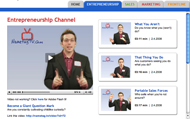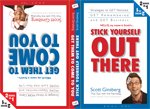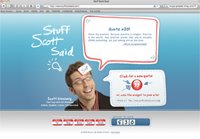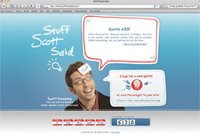 Yesterday we explored five ways to write more honestly. Here are six more:
Yesterday we explored five ways to write more honestly. Here are six more:
1. Listen to your body. If your words are felt in the body – your body mainly, but also the bodies of your readers – well done. That’s what honesty feels like. Pings. Blood flushes. Chills. Spine tingles. Neck hair stand-ups. Jaw drops. Eye wideners. Speechlessness. Laughs. ESPECIALLY laughs.
The point is: Emotion is the final arbiter of truth. And your body never lies to you. As my favorite fiction writer Tom Robbins advised, “You should always write with an erection. Even if you’re a woman.” How else will you know if your work is honest?
READ THIS BLOODY WRITER: Parker Palmer.
2. Write early in the morning. I do most of my writing between four and ten in the morning. Not because I’m a morning person. But because when the world is cold, dark and quiet, there’s nothing left to listen to but your truth.
Not your dogs. Not your phone. Not your email. Not your self-constructed crazybusy schedule. Not the voice of perfection. Not the echoes of people you’re trying to please. Not the endless demands of your readership. Not the scars of your past desperately trying to prevent your truth from surfacing. And non your ego scrambling to remind you that you’re not good enough to publish this thought.
Just quiet. Which means all you can hear is yourself. Which means there’s nothing or no one to stop you from bleeding your truth all over the page. Ultimately, when the sun isn’t up yet, you ALWAYS extract truth from the deepest parts of yourself. Superficiality not included. You unveil the truth that doesn’t require thinking. The truth that doesn’t require editing. You can’t edit blood anyway.
Remember: The darker it is outside, the more honest your thoughts are inside. As Henry Miller once wrote, “Every man, when he gets quiet, when he becomes desperately honest with himself, is capable of uttering profound truths.” What time did you start writing today?
READ THIS BLOODY WRITER: Dan Brown.
3. Go there. Good lord. Did he really just say that? Yes. Yes you did. THAT just happened. You went there. You took a chance and told the truth. Good for you. Keep it up. That’s the acid test: If you can picture your readers being moved, getting disturbed and squirming in their Snuggies.
If you can take them somewhere they didn’t want to go (or never thought they’d go) and make them grateful that you did by the time they got there. Remember: No reader will ever put a book down and say, “Screw this book. This author is just WAY too honest. I wonder if Law & Order is on…” Where are you willing to take your readers?
READ THIS BLOODY WRITER: Brad Warner.
4. Ask penetrating questions. If you’ve ever read my work before, you know I ask a lot of questions. Always in italics, usually in the past tense, mainly at the end of paragraphs. That’s my writing style. And I do it for two reasons. First, I love questions. It’s not a punctuation mark; it’s a way of life. I have a collection of 7000 of them, to which I add new questions daily. What can I say: I’m incurably curious.
Second, I insert them into my material intentionally to challenge, inspire, penetrate, disturb and confront the reader. I want to toggle their brains. Ideally to the point of being pissed off. Not at ME, but pissed off at what the material elicited. I call this Strategic Urination. More on that later. How many questions did your last blog post ask?
READ THIS BLOODY WRITER: Jeffrey Gitomer.
5. Commit to self-disclosure. My mentor once told me that good writing is like walking across a stage naked. Vulnerable. Open. Honest. Would YOUR readers use those adjectives to describe your work? If not, maybe it’s time to ditch your skivvies and show the world your giblets.
Take it from someone who wears a nametag 24-7: Self-disclosure is a healthy, beautiful and approachable thing. As long as you’re doing so to make a point – not just to get a laugh, or to use your readers as group therapy. TMI only applies if you don’t stick the landing and make your material actionable.
Remember: The more personal your writing is, the more your readers relate to it. How are you leveraging your vulnerabilities to earn readers’ trust?
READ THIS BLOODY WRITER: William Jenkins (my mentor).
6. Speak from experience. As hard as it is for me to admit it, reading thousands of books is (still) not experience. Knowledge, yes. Wisdom, no. Experience comes from doing. Your challenge is to speak from practice, not from pretension. Readers can tell the difference.
A writer who does nothing but quote a bunch of dead white guys isn’t an honest writer. A writer who interviews a bunch of successful people and then adds a few sentences of marginally insightful clichés at the end of each chapter isn’t a very honest writer.
And a writer who goes out of his way to use clumsy, twenty-five cent words to compensate for his sub-par creativity is not a very honest writer. Honesty is writing a book about the lessons you learned from the stupid mistakes you made and the actionable steps attached to them. Are you delivering knowledge or wisdom?
READ THIS BLOODY WRITER: Larry Winget.
REMEMBER: Honest writing scares people.
Good. That’s your job. The Boogie Man’s got nothing on you.
In conclusion, I’m reminded of the advice of Tennessee Williams, who said, “If the writing is honest it cannot be separated from the man who wrote it.”
Slice open a vein and bleed your truth all over the page.
LET ME ASK YA THIS…
Are you a bloody writer?
LET ME SUGGEST THIS…
For the list called, “9 Things Every Writer Needs to Do Every Day,” send an email to me, and you win the list for free!
* * * *
Scott Ginsberg
That Guy with the Nametag
Author, Speaker, Coach, Entrepreneur
[email protected]
 Need to build your Thought Leadership Platform?
Need to build your Thought Leadership Platform?
Perhaps my monthly (or yearly) coaching program would help.
Rent Scott’s Brain today!

 My definition of writing is as follows:
My definition of writing is as follows: “Why isn’t anybody joining our organization?!”
“Why isn’t anybody joining our organization?!”
 “Was I deceived, or did a sable cloud turn forth her silver lining on the night?”
“Was I deceived, or did a sable cloud turn forth her silver lining on the night?”
 1. People are classrooms. They contain volumes. And as such, deserve to be treated with deep democracy. Even if you don’t like them. Even if you have the urge to “accidentally” push them out of the fourteenth story window of your office.
1. People are classrooms. They contain volumes. And as such, deserve to be treated with deep democracy. Even if you don’t like them. Even if you have the urge to “accidentally” push them out of the fourteenth story window of your office.  The world’s FIRST two-in-one, flip-flop book!
The world’s FIRST two-in-one, flip-flop book! Today is day 3,367 of wearing a nametag 24-7.
Today is day 3,367 of wearing a nametag 24-7. Who’s quoting YOU?
Who’s quoting YOU? 1. Do as I say AND as I do. Life your life of zero distinction between the two. Where the message you’re preaching is the dominant reality of your life. Where your footsteps are in line with your mouthsteps. And where your onstage performance is congruent with your backstage reality. In what areas of your life are you forgetting to partner with integrity?
1. Do as I say AND as I do. Life your life of zero distinction between the two. Where the message you’re preaching is the dominant reality of your life. Where your footsteps are in line with your mouthsteps. And where your onstage performance is congruent with your backstage reality. In what areas of your life are you forgetting to partner with integrity? Who’s quoting YOU?
Who’s quoting YOU? According to
According to 